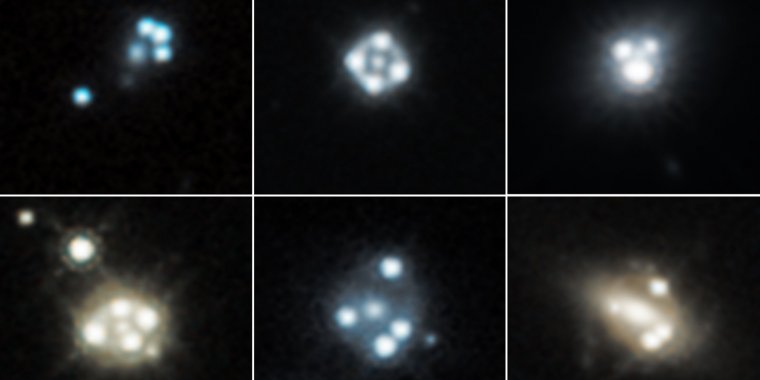| News / Science News |
Cosmic Magnifying Glasses Find Dark Matter in Small Clumps
Using NASA's Hubble Space Telescope and a new observing technique, astronomers have found that dark matter forms much smaller clumps than previously known. This result confirms one of the fundamental predictions of the widely accepted "cold dark matter" theory.

Each snapshot shows four distorted images of a background quasar (an extremely bright region in the center of some distant galaxies), surrounding the core of a massive foreground galaxy. The gravity of the foreground galaxy magnifies the quasar, an effect called gravitational lensing. Credit: NASA/ESA/A. Nierenberg/T. Treu
All galaxies, according to this theory, form and are embedded within clouds of dark matter. Dark matter itself consists of slow-moving, or "cold," particles that come together to form structures ranging from hundreds of thousands of times the mass of the Milky Way galaxy to clumps no more massive than the heft of a commercial airplane. (In this context, "cold" refers to the particles' speed.)
Dark matter is an invisible form of matter that makes up the bulk of the universe's mass and creates the scaffolding upon which galaxies are built.
Although astronomers cannot see dark matter, they can detect its presence indirectly by measuring how its gravity affects stars and galaxies. Detecting the smallest dark matter formations by looking for embedded stars can be difficult or impossible because they contain very few stars.
While dark matter concentrations have been detected around large- and medium-sized galaxies, much smaller clumps of dark matter have not been found until now. In the absence of observational evidence for such small-scale clumps, some researchers have developed alternative theories, including "warm dark matter."
This idea suggests that dark matter particles are fast moving, zipping along too quickly to merge and form smaller concentrations. The new observations do not support this scenario, finding that dark matter is "colder" than it would have to be in the warm dark matter alternative theory.
"Dark matter is colder than we knew at smaller scales," said Anna Nierenberg of NASA's Jet Propulsion Laboratory in Pasadena, California, leader of the Hubble survey. "Astronomers have carried out other observational tests of dark matter theories before, but ours provides the strongest evidence yet for the presence of small clumps of cold dark matter.
By combining the latest theoretical predictions, statistical tools and new Hubble observations, we now have a much more robust result than was previously possible."
Hunting for dark matter concentrations devoid of stars has proved challenging. The Hubble research team, however, used a technique in which they did not need to look for the gravitational influence of stars as tracers of dark matter.
The team targeted eight powerful and distant cosmic "streetlights," called quasars (regions around active black holes that emit enormous amounts of light). The astronomers measured how the light emitted by oxygen and neon gas orbiting each of the quasars' black holes is warped by the gravity of a massive foreground galaxy, which acts as a magnifying lens.
Using this method, the team uncovered dark matter clumps along the telescope's line of sight to the quasars, as well as in and around the intervening lensing galaxies.
The dark matter concentrations detected by Hubble are 1/10,000th to 1/100,000th times the mass of the Milky Way's dark matter halo. Many of these tiny groupings most likely do not contain even small galaxies, and therefore would have been impossible to detect by the traditional method of looking for embedded stars.
The eight quasars and galaxies were aligned so precisely that the warping effect, called gravitational lensing, produced four distorted images of each quasar. The effect is like looking at a funhouse mirror. (NASA)
YOU MAY ALSO LIKE





